Managing People: Executive Report on H&M HR Practices
VerifiedAdded on 2020/03/16
|13
|3061
|48
Report
AI Summary
This report provides a comprehensive analysis of Hennes & Mauritz (H&M)'s human resource practices. It examines various aspects, including job ability, employee motivation influenced by Maslow's hierarchy of needs, and the company's reward systems, which include financial and non-financial incentives, and opportunities for employee development. The report also investigates H&M's approach to employment relations, health and safety legislations, and performance management, with detailed discussions on development, appraisal, and disciplinary components. The findings highlight the company's strengths in employee motivation, rewards, and development programs, as well as weaknesses in its appraisal and disciplinary processes. The report concludes with recommendations for improvement, such as incorporating promotions as a motivational tool and encouraging more social interactions, aiming to enhance overall organizational effectiveness and employee satisfaction. The report is based on secondary literature and provides valuable insights into H&M's HR strategies.
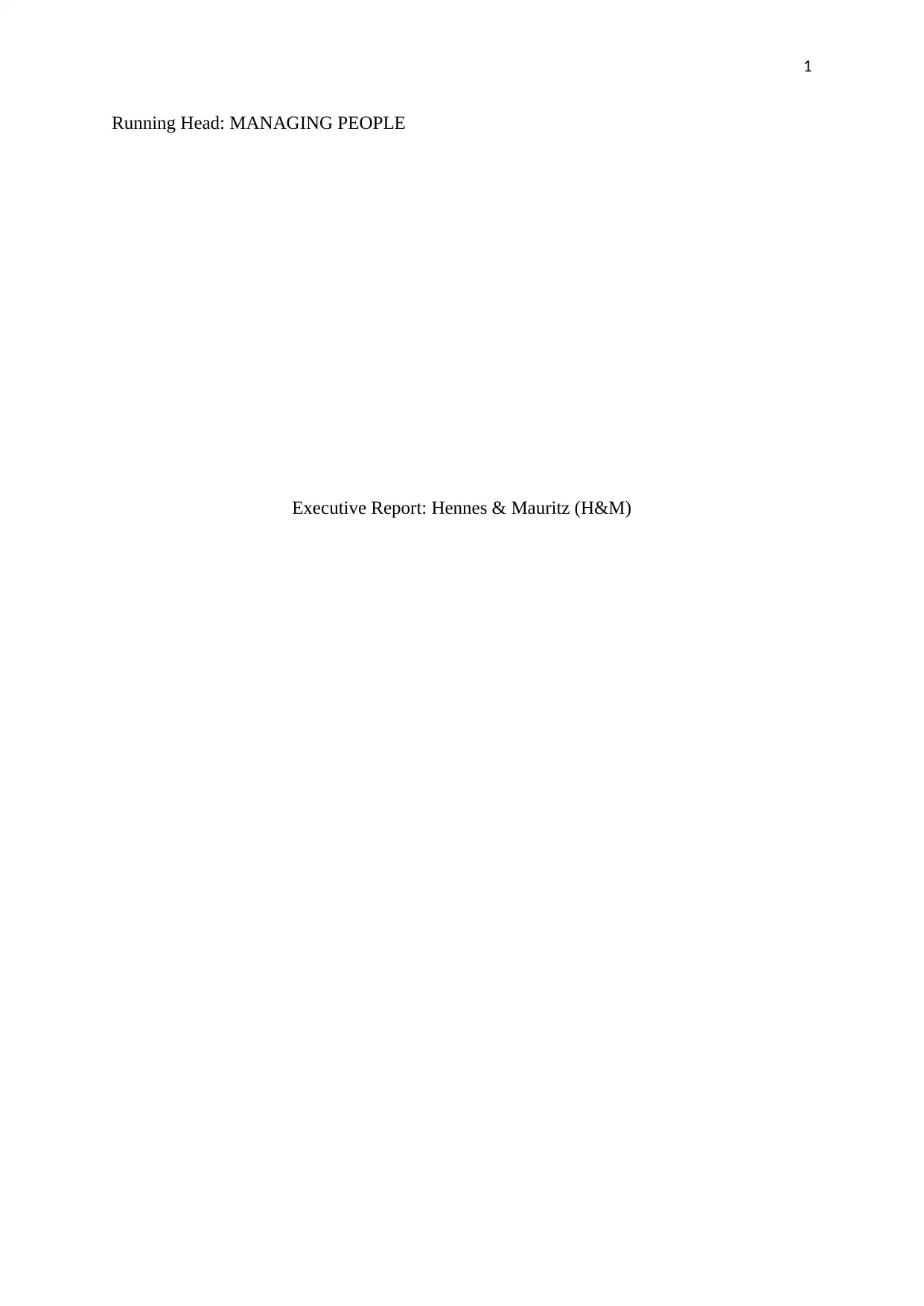
1
Running Head: MANAGING PEOPLE
Executive Report: Hennes & Mauritz (H&M)
Running Head: MANAGING PEOPLE
Executive Report: Hennes & Mauritz (H&M)
Paraphrase This Document
Need a fresh take? Get an instant paraphrase of this document with our AI Paraphraser
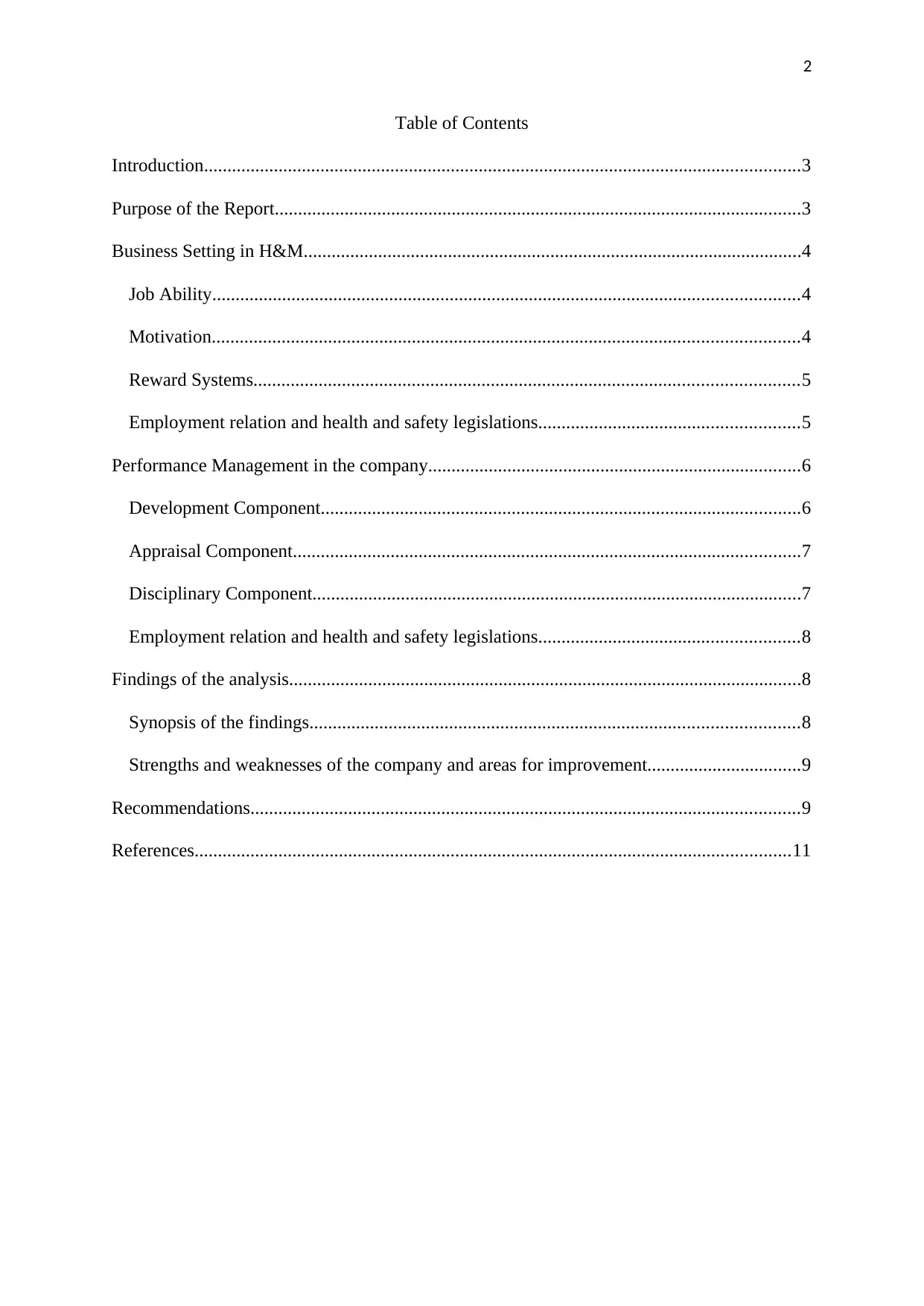
2
Table of Contents
Introduction................................................................................................................................3
Purpose of the Report.................................................................................................................3
Business Setting in H&M...........................................................................................................4
Job Ability..............................................................................................................................4
Motivation..............................................................................................................................4
Reward Systems.....................................................................................................................5
Employment relation and health and safety legislations........................................................5
Performance Management in the company................................................................................6
Development Component.......................................................................................................6
Appraisal Component.............................................................................................................7
Disciplinary Component.........................................................................................................7
Employment relation and health and safety legislations........................................................8
Findings of the analysis..............................................................................................................8
Synopsis of the findings.........................................................................................................8
Strengths and weaknesses of the company and areas for improvement.................................9
Recommendations......................................................................................................................9
References................................................................................................................................11
Table of Contents
Introduction................................................................................................................................3
Purpose of the Report.................................................................................................................3
Business Setting in H&M...........................................................................................................4
Job Ability..............................................................................................................................4
Motivation..............................................................................................................................4
Reward Systems.....................................................................................................................5
Employment relation and health and safety legislations........................................................5
Performance Management in the company................................................................................6
Development Component.......................................................................................................6
Appraisal Component.............................................................................................................7
Disciplinary Component.........................................................................................................7
Employment relation and health and safety legislations........................................................8
Findings of the analysis..............................................................................................................8
Synopsis of the findings.........................................................................................................8
Strengths and weaknesses of the company and areas for improvement.................................9
Recommendations......................................................................................................................9
References................................................................................................................................11

3
Introduction
The following report focuses on a case study of the company Hennes & Mauritz
(H&M), which is a Swedish retail company dealing in clothing. The company is popular for
its fast fashion clothing options for kids, men, teenagers, and women. The company has
approximately 4500 stores which are located in more than 62 countries. The company also
deals in online retailing providing its shoppers experience in online shopping.
The company has a huge employee and customer base which has made it the second
largest clothing retail chain (H&M Group, 2017). This report aims at discussing the HR
practices of the company with respect to motivation, performance management, rewards
system, and health and safety legislations. The audience for this report is the management of
H&M. the report is based on the secondary literature and no primary data has been gathered
for this report which serves as its limitation.
Purpose of the Report
The aim of this report is to analyze the HR practices that are employed by the
company, H&M in managing its employees. In order to attain the aim of this report
successfully, following objectives have been developed.
To understand the business setting of the company in relation to job ability,
motivation and reward systems adopted by the company
To gain an insight on the employment relations and health and safety legislations
adopted by the company
To understand the performance management of the company with the application of
suitable models and theories
To make recommendations for the gaps identified and for the enhancement of
organizational effectiveness and efficiency.
Introduction
The following report focuses on a case study of the company Hennes & Mauritz
(H&M), which is a Swedish retail company dealing in clothing. The company is popular for
its fast fashion clothing options for kids, men, teenagers, and women. The company has
approximately 4500 stores which are located in more than 62 countries. The company also
deals in online retailing providing its shoppers experience in online shopping.
The company has a huge employee and customer base which has made it the second
largest clothing retail chain (H&M Group, 2017). This report aims at discussing the HR
practices of the company with respect to motivation, performance management, rewards
system, and health and safety legislations. The audience for this report is the management of
H&M. the report is based on the secondary literature and no primary data has been gathered
for this report which serves as its limitation.
Purpose of the Report
The aim of this report is to analyze the HR practices that are employed by the
company, H&M in managing its employees. In order to attain the aim of this report
successfully, following objectives have been developed.
To understand the business setting of the company in relation to job ability,
motivation and reward systems adopted by the company
To gain an insight on the employment relations and health and safety legislations
adopted by the company
To understand the performance management of the company with the application of
suitable models and theories
To make recommendations for the gaps identified and for the enhancement of
organizational effectiveness and efficiency.
⊘ This is a preview!⊘
Do you want full access?
Subscribe today to unlock all pages.

Trusted by 1+ million students worldwide

4
Business Setting in H&M
It is essential for the organizations to manage its most important asset, that is, its
employees. If the employees are satisfied in the organization, it is likely that the company has
better productivity and profitability.
1. Job Ability
The job ability refers to the different skills required by the employees to carry out
their work duties. The company requires different job abilities for different job positions;
however, there are certain abilities and qualities that are to be present in an individual to work
for the company. The company looks for those individuals who are passionate and dedicated
towards fashion and design, are focused on achieving customer satisfaction.
It also looks for people who are business driven, and who have a similar set of values
as that of the company (H&M, 2016). Apart from these basic job abilities, employees
working in different departments are required to have the relevant expertise. For example, a
sales employee is required to have the convincing ability, presentation skills, and effective
communication abilities.
2. Motivation
The company's HR strategy is influenced by the Maslow's need Hierarch theory
which indicates that there are five level of needs, the satisfaction of each need level motivates
an individual to move to the higher level of needs (Maslow, 2013). In the context of H&M,
the company is offering a good salary, incentives and opportunities for establishing networks
within the organization (H&M, 2016).
Its H&M incentive program ensures long-term commitment and involvement of its
employees, which as per the Maslow’s theory are satisfying the physiological, safety, and
belongingness needs (H&M, 2017). The company is also allowing its employees with proper
opportunities to accomplish their self-esteem and self-actualization needs and for their
Business Setting in H&M
It is essential for the organizations to manage its most important asset, that is, its
employees. If the employees are satisfied in the organization, it is likely that the company has
better productivity and profitability.
1. Job Ability
The job ability refers to the different skills required by the employees to carry out
their work duties. The company requires different job abilities for different job positions;
however, there are certain abilities and qualities that are to be present in an individual to work
for the company. The company looks for those individuals who are passionate and dedicated
towards fashion and design, are focused on achieving customer satisfaction.
It also looks for people who are business driven, and who have a similar set of values
as that of the company (H&M, 2016). Apart from these basic job abilities, employees
working in different departments are required to have the relevant expertise. For example, a
sales employee is required to have the convincing ability, presentation skills, and effective
communication abilities.
2. Motivation
The company's HR strategy is influenced by the Maslow's need Hierarch theory
which indicates that there are five level of needs, the satisfaction of each need level motivates
an individual to move to the higher level of needs (Maslow, 2013). In the context of H&M,
the company is offering a good salary, incentives and opportunities for establishing networks
within the organization (H&M, 2016).
Its H&M incentive program ensures long-term commitment and involvement of its
employees, which as per the Maslow’s theory are satisfying the physiological, safety, and
belongingness needs (H&M, 2017). The company is also allowing its employees with proper
opportunities to accomplish their self-esteem and self-actualization needs and for their
Paraphrase This Document
Need a fresh take? Get an instant paraphrase of this document with our AI Paraphraser
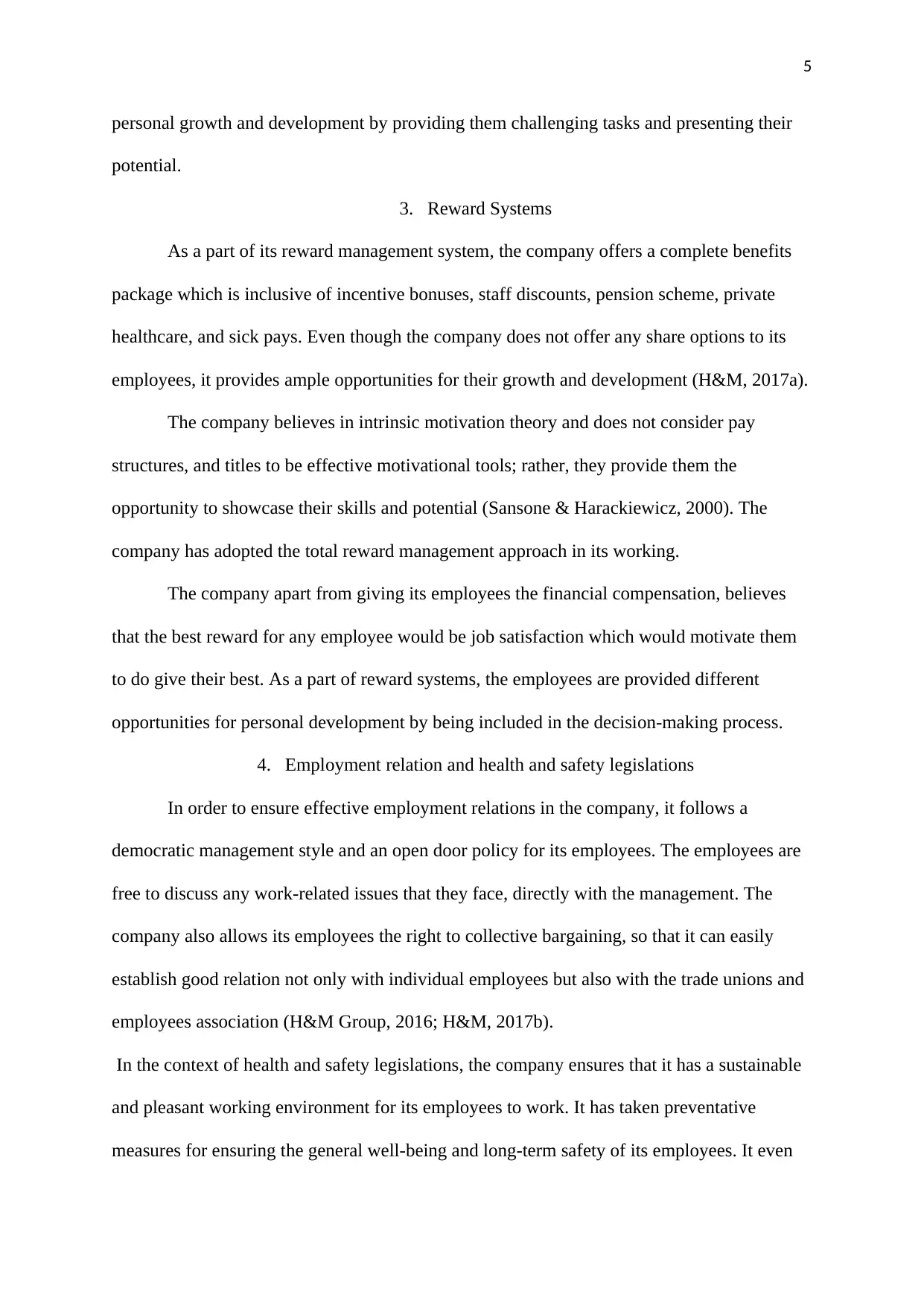
5
personal growth and development by providing them challenging tasks and presenting their
potential.
3. Reward Systems
As a part of its reward management system, the company offers a complete benefits
package which is inclusive of incentive bonuses, staff discounts, pension scheme, private
healthcare, and sick pays. Even though the company does not offer any share options to its
employees, it provides ample opportunities for their growth and development (H&M, 2017a).
The company believes in intrinsic motivation theory and does not consider pay
structures, and titles to be effective motivational tools; rather, they provide them the
opportunity to showcase their skills and potential (Sansone & Harackiewicz, 2000). The
company has adopted the total reward management approach in its working.
The company apart from giving its employees the financial compensation, believes
that the best reward for any employee would be job satisfaction which would motivate them
to do give their best. As a part of reward systems, the employees are provided different
opportunities for personal development by being included in the decision-making process.
4. Employment relation and health and safety legislations
In order to ensure effective employment relations in the company, it follows a
democratic management style and an open door policy for its employees. The employees are
free to discuss any work-related issues that they face, directly with the management. The
company also allows its employees the right to collective bargaining, so that it can easily
establish good relation not only with individual employees but also with the trade unions and
employees association (H&M Group, 2016; H&M, 2017b).
In the context of health and safety legislations, the company ensures that it has a sustainable
and pleasant working environment for its employees to work. It has taken preventative
measures for ensuring the general well-being and long-term safety of its employees. It even
personal growth and development by providing them challenging tasks and presenting their
potential.
3. Reward Systems
As a part of its reward management system, the company offers a complete benefits
package which is inclusive of incentive bonuses, staff discounts, pension scheme, private
healthcare, and sick pays. Even though the company does not offer any share options to its
employees, it provides ample opportunities for their growth and development (H&M, 2017a).
The company believes in intrinsic motivation theory and does not consider pay
structures, and titles to be effective motivational tools; rather, they provide them the
opportunity to showcase their skills and potential (Sansone & Harackiewicz, 2000). The
company has adopted the total reward management approach in its working.
The company apart from giving its employees the financial compensation, believes
that the best reward for any employee would be job satisfaction which would motivate them
to do give their best. As a part of reward systems, the employees are provided different
opportunities for personal development by being included in the decision-making process.
4. Employment relation and health and safety legislations
In order to ensure effective employment relations in the company, it follows a
democratic management style and an open door policy for its employees. The employees are
free to discuss any work-related issues that they face, directly with the management. The
company also allows its employees the right to collective bargaining, so that it can easily
establish good relation not only with individual employees but also with the trade unions and
employees association (H&M Group, 2016; H&M, 2017b).
In the context of health and safety legislations, the company ensures that it has a sustainable
and pleasant working environment for its employees to work. It has taken preventative
measures for ensuring the general well-being and long-term safety of its employees. It even
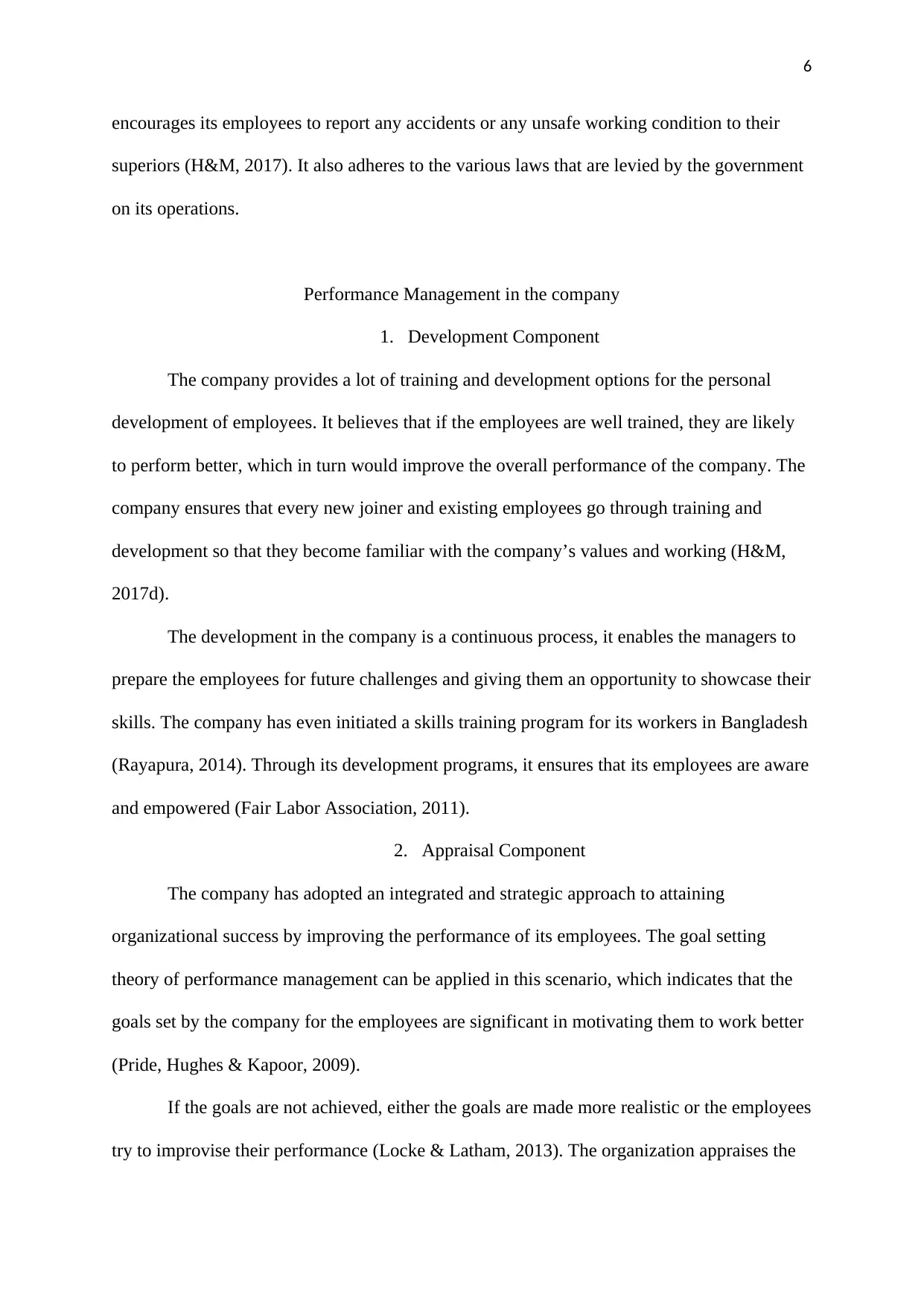
6
encourages its employees to report any accidents or any unsafe working condition to their
superiors (H&M, 2017). It also adheres to the various laws that are levied by the government
on its operations.
Performance Management in the company
1. Development Component
The company provides a lot of training and development options for the personal
development of employees. It believes that if the employees are well trained, they are likely
to perform better, which in turn would improve the overall performance of the company. The
company ensures that every new joiner and existing employees go through training and
development so that they become familiar with the company’s values and working (H&M,
2017d).
The development in the company is a continuous process, it enables the managers to
prepare the employees for future challenges and giving them an opportunity to showcase their
skills. The company has even initiated a skills training program for its workers in Bangladesh
(Rayapura, 2014). Through its development programs, it ensures that its employees are aware
and empowered (Fair Labor Association, 2011).
2. Appraisal Component
The company has adopted an integrated and strategic approach to attaining
organizational success by improving the performance of its employees. The goal setting
theory of performance management can be applied in this scenario, which indicates that the
goals set by the company for the employees are significant in motivating them to work better
(Pride, Hughes & Kapoor, 2009).
If the goals are not achieved, either the goals are made more realistic or the employees
try to improvise their performance (Locke & Latham, 2013). The organization appraises the
encourages its employees to report any accidents or any unsafe working condition to their
superiors (H&M, 2017). It also adheres to the various laws that are levied by the government
on its operations.
Performance Management in the company
1. Development Component
The company provides a lot of training and development options for the personal
development of employees. It believes that if the employees are well trained, they are likely
to perform better, which in turn would improve the overall performance of the company. The
company ensures that every new joiner and existing employees go through training and
development so that they become familiar with the company’s values and working (H&M,
2017d).
The development in the company is a continuous process, it enables the managers to
prepare the employees for future challenges and giving them an opportunity to showcase their
skills. The company has even initiated a skills training program for its workers in Bangladesh
(Rayapura, 2014). Through its development programs, it ensures that its employees are aware
and empowered (Fair Labor Association, 2011).
2. Appraisal Component
The company has adopted an integrated and strategic approach to attaining
organizational success by improving the performance of its employees. The goal setting
theory of performance management can be applied in this scenario, which indicates that the
goals set by the company for the employees are significant in motivating them to work better
(Pride, Hughes & Kapoor, 2009).
If the goals are not achieved, either the goals are made more realistic or the employees
try to improvise their performance (Locke & Latham, 2013). The organization appraises the
⊘ This is a preview!⊘
Do you want full access?
Subscribe today to unlock all pages.

Trusted by 1+ million students worldwide
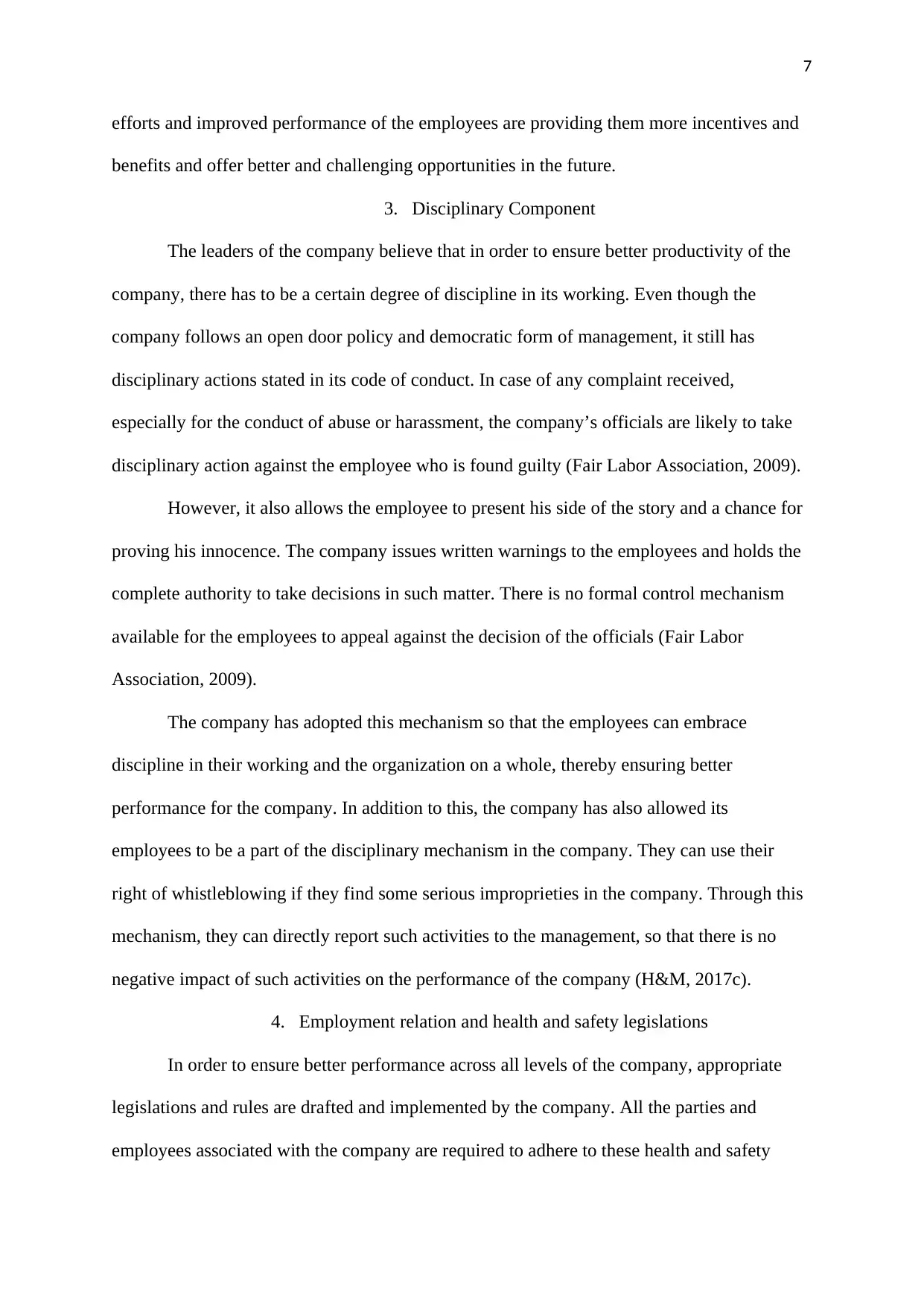
7
efforts and improved performance of the employees are providing them more incentives and
benefits and offer better and challenging opportunities in the future.
3. Disciplinary Component
The leaders of the company believe that in order to ensure better productivity of the
company, there has to be a certain degree of discipline in its working. Even though the
company follows an open door policy and democratic form of management, it still has
disciplinary actions stated in its code of conduct. In case of any complaint received,
especially for the conduct of abuse or harassment, the company’s officials are likely to take
disciplinary action against the employee who is found guilty (Fair Labor Association, 2009).
However, it also allows the employee to present his side of the story and a chance for
proving his innocence. The company issues written warnings to the employees and holds the
complete authority to take decisions in such matter. There is no formal control mechanism
available for the employees to appeal against the decision of the officials (Fair Labor
Association, 2009).
The company has adopted this mechanism so that the employees can embrace
discipline in their working and the organization on a whole, thereby ensuring better
performance for the company. In addition to this, the company has also allowed its
employees to be a part of the disciplinary mechanism in the company. They can use their
right of whistleblowing if they find some serious improprieties in the company. Through this
mechanism, they can directly report such activities to the management, so that there is no
negative impact of such activities on the performance of the company (H&M, 2017c).
4. Employment relation and health and safety legislations
In order to ensure better performance across all levels of the company, appropriate
legislations and rules are drafted and implemented by the company. All the parties and
employees associated with the company are required to adhere to these health and safety
efforts and improved performance of the employees are providing them more incentives and
benefits and offer better and challenging opportunities in the future.
3. Disciplinary Component
The leaders of the company believe that in order to ensure better productivity of the
company, there has to be a certain degree of discipline in its working. Even though the
company follows an open door policy and democratic form of management, it still has
disciplinary actions stated in its code of conduct. In case of any complaint received,
especially for the conduct of abuse or harassment, the company’s officials are likely to take
disciplinary action against the employee who is found guilty (Fair Labor Association, 2009).
However, it also allows the employee to present his side of the story and a chance for
proving his innocence. The company issues written warnings to the employees and holds the
complete authority to take decisions in such matter. There is no formal control mechanism
available for the employees to appeal against the decision of the officials (Fair Labor
Association, 2009).
The company has adopted this mechanism so that the employees can embrace
discipline in their working and the organization on a whole, thereby ensuring better
performance for the company. In addition to this, the company has also allowed its
employees to be a part of the disciplinary mechanism in the company. They can use their
right of whistleblowing if they find some serious improprieties in the company. Through this
mechanism, they can directly report such activities to the management, so that there is no
negative impact of such activities on the performance of the company (H&M, 2017c).
4. Employment relation and health and safety legislations
In order to ensure better performance across all levels of the company, appropriate
legislations and rules are drafted and implemented by the company. All the parties and
employees associated with the company are required to adhere to these health and safety
Paraphrase This Document
Need a fresh take? Get an instant paraphrase of this document with our AI Paraphraser

8
standards. These rules are related to building safety, fire safety, accidents and first aid, and
working environment.
The company also ensures that the rights of its employees are also well protected and
the laws relating to wages, working hours, benefits, and leaves are duly adhered (H&M,
2010). The safety and health of the employees hold a priority for the company as it considers
it employees the main asset.
Findings of the analysis
1. Synopsis of the findings
The analysis of the company’s practices reveals that the company has adopted
effective measures for rewarding and motivating its employees. It has developed various
training and development programs for all its employees, whether new recruits or the existing
employees.
These programs lead to the personal development of employees and ensure that the
employees are well aware of the company's values, incorporate the learning in their work.
The core of the company’s success is its employees who give their maximum efforts in
improving the overall performance and productivity of the company.
2. Strengths and weaknesses of the company and areas for improvement
From the analysis of the company’s processes, it has been identified that the strength
of the company lies in its rewards system, motivational practices, and development
component of its performance management mechanism. It is revealed that the company has
adopted effective training programs for the development of its employees which helps them
in performing their jobs in a better manner and thereby improving the performance of the
overall company.
standards. These rules are related to building safety, fire safety, accidents and first aid, and
working environment.
The company also ensures that the rights of its employees are also well protected and
the laws relating to wages, working hours, benefits, and leaves are duly adhered (H&M,
2010). The safety and health of the employees hold a priority for the company as it considers
it employees the main asset.
Findings of the analysis
1. Synopsis of the findings
The analysis of the company’s practices reveals that the company has adopted
effective measures for rewarding and motivating its employees. It has developed various
training and development programs for all its employees, whether new recruits or the existing
employees.
These programs lead to the personal development of employees and ensure that the
employees are well aware of the company's values, incorporate the learning in their work.
The core of the company’s success is its employees who give their maximum efforts in
improving the overall performance and productivity of the company.
2. Strengths and weaknesses of the company and areas for improvement
From the analysis of the company’s processes, it has been identified that the strength
of the company lies in its rewards system, motivational practices, and development
component of its performance management mechanism. It is revealed that the company has
adopted effective training programs for the development of its employees which helps them
in performing their jobs in a better manner and thereby improving the performance of the
overall company.
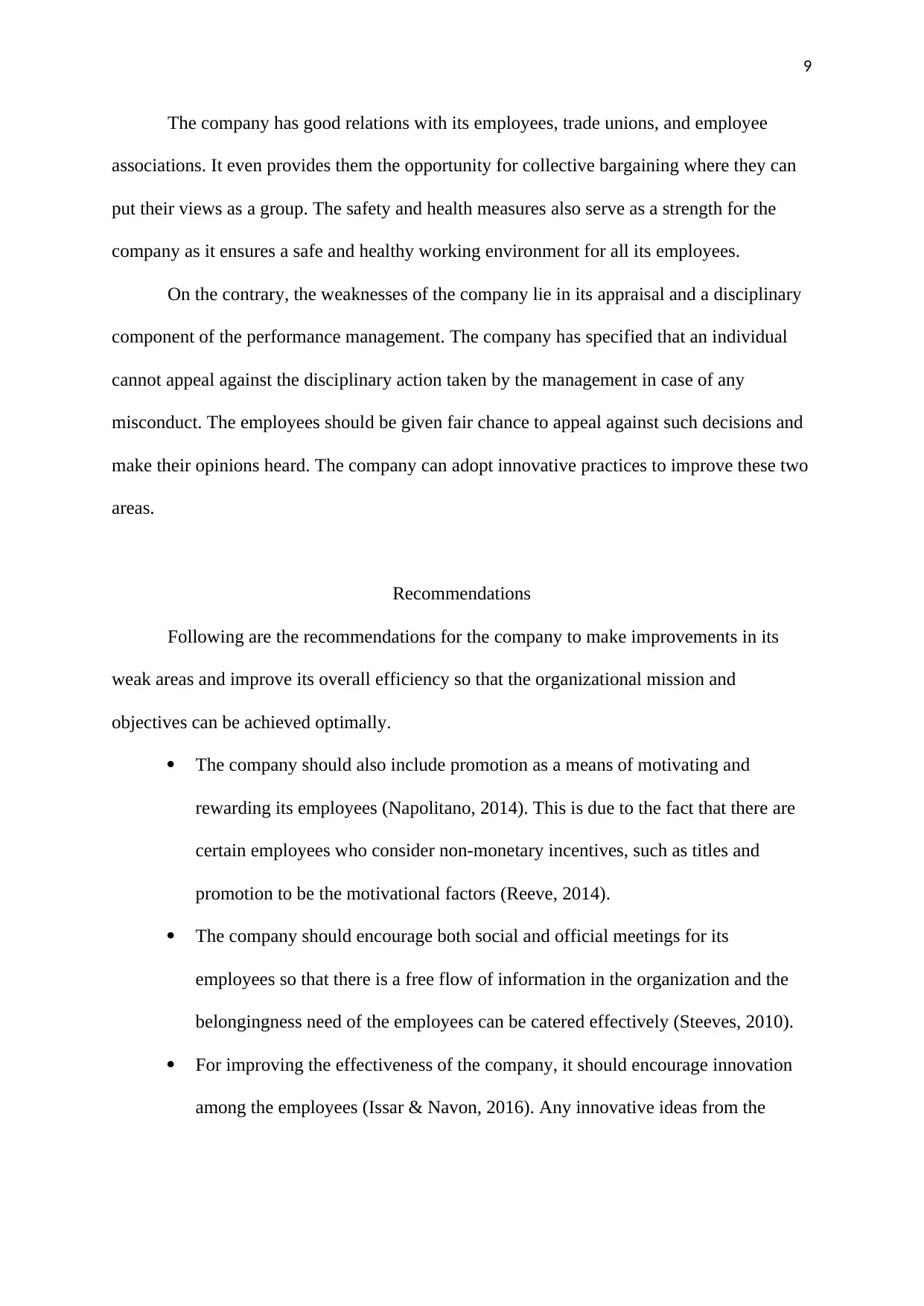
9
The company has good relations with its employees, trade unions, and employee
associations. It even provides them the opportunity for collective bargaining where they can
put their views as a group. The safety and health measures also serve as a strength for the
company as it ensures a safe and healthy working environment for all its employees.
On the contrary, the weaknesses of the company lie in its appraisal and a disciplinary
component of the performance management. The company has specified that an individual
cannot appeal against the disciplinary action taken by the management in case of any
misconduct. The employees should be given fair chance to appeal against such decisions and
make their opinions heard. The company can adopt innovative practices to improve these two
areas.
Recommendations
Following are the recommendations for the company to make improvements in its
weak areas and improve its overall efficiency so that the organizational mission and
objectives can be achieved optimally.
The company should also include promotion as a means of motivating and
rewarding its employees (Napolitano, 2014). This is due to the fact that there are
certain employees who consider non-monetary incentives, such as titles and
promotion to be the motivational factors (Reeve, 2014).
The company should encourage both social and official meetings for its
employees so that there is a free flow of information in the organization and the
belongingness need of the employees can be catered effectively (Steeves, 2010).
For improving the effectiveness of the company, it should encourage innovation
among the employees (Issar & Navon, 2016). Any innovative ideas from the
The company has good relations with its employees, trade unions, and employee
associations. It even provides them the opportunity for collective bargaining where they can
put their views as a group. The safety and health measures also serve as a strength for the
company as it ensures a safe and healthy working environment for all its employees.
On the contrary, the weaknesses of the company lie in its appraisal and a disciplinary
component of the performance management. The company has specified that an individual
cannot appeal against the disciplinary action taken by the management in case of any
misconduct. The employees should be given fair chance to appeal against such decisions and
make their opinions heard. The company can adopt innovative practices to improve these two
areas.
Recommendations
Following are the recommendations for the company to make improvements in its
weak areas and improve its overall efficiency so that the organizational mission and
objectives can be achieved optimally.
The company should also include promotion as a means of motivating and
rewarding its employees (Napolitano, 2014). This is due to the fact that there are
certain employees who consider non-monetary incentives, such as titles and
promotion to be the motivational factors (Reeve, 2014).
The company should encourage both social and official meetings for its
employees so that there is a free flow of information in the organization and the
belongingness need of the employees can be catered effectively (Steeves, 2010).
For improving the effectiveness of the company, it should encourage innovation
among the employees (Issar & Navon, 2016). Any innovative ideas from the
⊘ This is a preview!⊘
Do you want full access?
Subscribe today to unlock all pages.

Trusted by 1+ million students worldwide
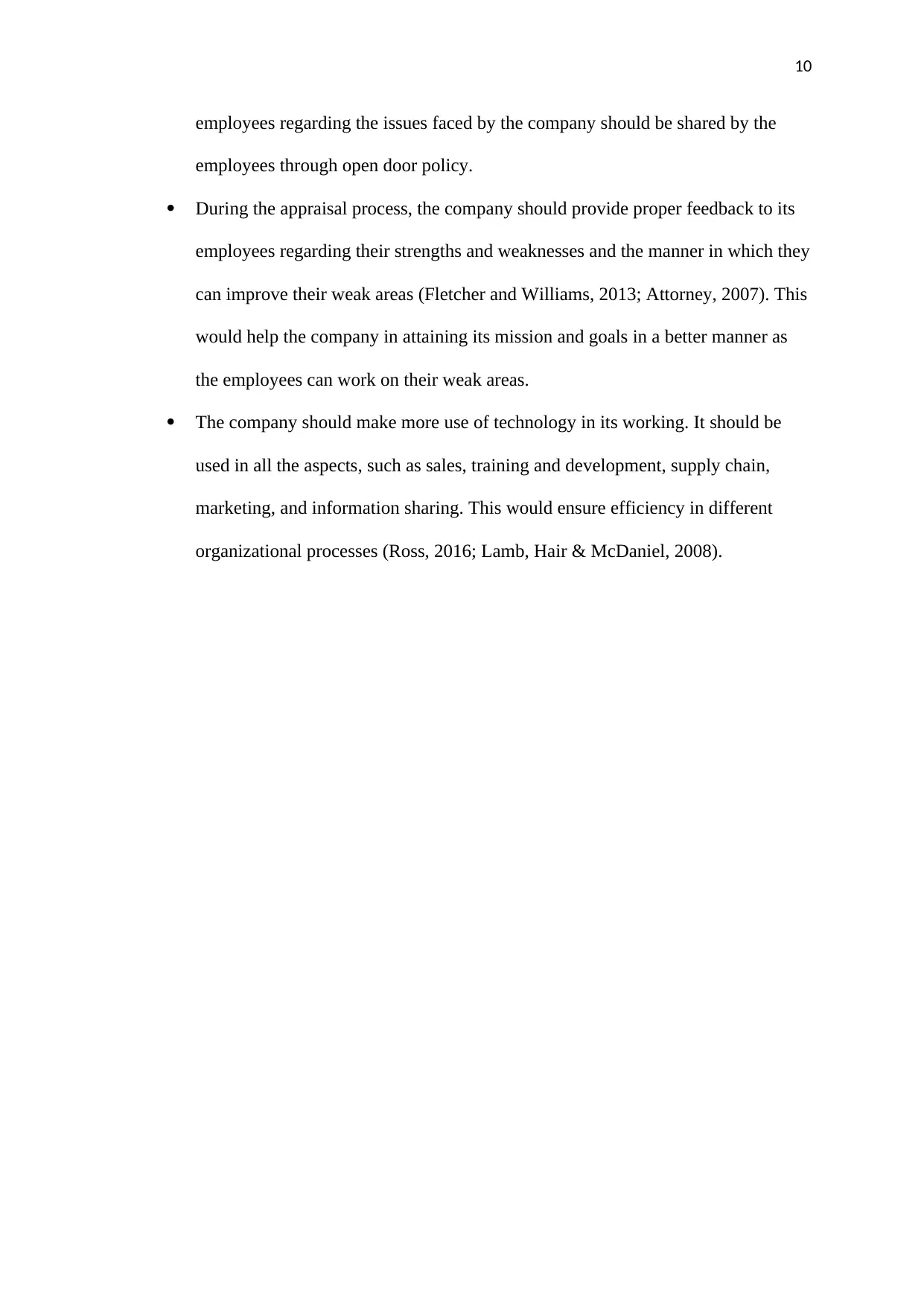
10
employees regarding the issues faced by the company should be shared by the
employees through open door policy.
During the appraisal process, the company should provide proper feedback to its
employees regarding their strengths and weaknesses and the manner in which they
can improve their weak areas (Fletcher and Williams, 2013; Attorney, 2007). This
would help the company in attaining its mission and goals in a better manner as
the employees can work on their weak areas.
The company should make more use of technology in its working. It should be
used in all the aspects, such as sales, training and development, supply chain,
marketing, and information sharing. This would ensure efficiency in different
organizational processes (Ross, 2016; Lamb, Hair & McDaniel, 2008).
employees regarding the issues faced by the company should be shared by the
employees through open door policy.
During the appraisal process, the company should provide proper feedback to its
employees regarding their strengths and weaknesses and the manner in which they
can improve their weak areas (Fletcher and Williams, 2013; Attorney, 2007). This
would help the company in attaining its mission and goals in a better manner as
the employees can work on their weak areas.
The company should make more use of technology in its working. It should be
used in all the aspects, such as sales, training and development, supply chain,
marketing, and information sharing. This would ensure efficiency in different
organizational processes (Ross, 2016; Lamb, Hair & McDaniel, 2008).
Paraphrase This Document
Need a fresh take? Get an instant paraphrase of this document with our AI Paraphraser

11
References
Attorney, A. D. (2007). Performance Appraisal Handbook. Berkeley: Nolo.
Fair Labor Association. (2009). Independent external monitoring report. Retrieved October
04, 2017, from http://digitalcommons.ilr.cornell.edu/cgi/viewcontent.cgi?
article=1978&context=globaldocs
Fair Labor Association. (2011). Training, Capacity Building Efforts Benefit Workers at
H&M Supplier Factory. Retrieved October 04, 2017, from
http://www.fairlabor.org/blog/entry/training-capacity-building-efforts-benefit-
workers-hm-supplier-factory
Fletcher, C. and Williams, R. (2013). Appraisal, Feedback and Development: Making
Performance Review Work. London: Routledge.
H&M Group. (2016). THE H&M Group Sustainability Report 2016. Retrieved October 04,
2017, from http://sustainability.hm.com/content/dam/hm/about/documents/en/CSR/
2016%20Sustainability%20report/
HM_group_SustainabilityReport_2016_FullReport_en.pdf
H&M Group. (2017). About Us. Retrieved October 04, 2017, from
http://about.hm.com/en/about-us.html#cm-menu
H&M. (2010). Code of Conduct. Retrieved October 04, 2017, from https://www.your-
bizbook.com/contentassets/ef398a110094413e961fae025bde0da6/code-of-
conduct_en.pdf
H&M. (2016). H&M Annual Report 2016. Retrieved October 04, 2017, from
https://about.hm.com/content/dam/hmgroup/groupsite/documents/masterlanguage/
Annual%20Report/Annual%20Report%202016.pdf
References
Attorney, A. D. (2007). Performance Appraisal Handbook. Berkeley: Nolo.
Fair Labor Association. (2009). Independent external monitoring report. Retrieved October
04, 2017, from http://digitalcommons.ilr.cornell.edu/cgi/viewcontent.cgi?
article=1978&context=globaldocs
Fair Labor Association. (2011). Training, Capacity Building Efforts Benefit Workers at
H&M Supplier Factory. Retrieved October 04, 2017, from
http://www.fairlabor.org/blog/entry/training-capacity-building-efforts-benefit-
workers-hm-supplier-factory
Fletcher, C. and Williams, R. (2013). Appraisal, Feedback and Development: Making
Performance Review Work. London: Routledge.
H&M Group. (2016). THE H&M Group Sustainability Report 2016. Retrieved October 04,
2017, from http://sustainability.hm.com/content/dam/hm/about/documents/en/CSR/
2016%20Sustainability%20report/
HM_group_SustainabilityReport_2016_FullReport_en.pdf
H&M Group. (2017). About Us. Retrieved October 04, 2017, from
http://about.hm.com/en/about-us.html#cm-menu
H&M. (2010). Code of Conduct. Retrieved October 04, 2017, from https://www.your-
bizbook.com/contentassets/ef398a110094413e961fae025bde0da6/code-of-
conduct_en.pdf
H&M. (2016). H&M Annual Report 2016. Retrieved October 04, 2017, from
https://about.hm.com/content/dam/hmgroup/groupsite/documents/masterlanguage/
Annual%20Report/Annual%20Report%202016.pdf

12
H&M. (2017a). Career at H&M. Retrieved October 04, 2017, from
https://career.hm.com/content/hmcareer/en_gb/workingathm/get-to-know-us/
benefits.html
H&M. (2017b). Our Workplace. Retrieved October 04, 2017, from
https://career.hm.com/content/hmcareer/en_gb/workingathm/get-to-know-us/our-
workplace.html
H&M. (2017c). Whistle Blowing. Retrieved October 04, 2017, from
https://about.hm.com/en/about-us/corporate-governance/whistle-blowing.html
H&M. (2017d). What you should know. Retrieved October 04, 2017, from
http://reviews.greatplacetowork.com/h-m
H&M. (2017). The H&M way. Retrieved October 04, 2017, from
https://about.hm.com/content/dam/hmgroup/groupsite/documents/en/hm-way/HM
%20Way_en.pdf
Issar, G., & Navon, L. R. (2016). Operational Excellence: A Concise Guide to Basic
Concepts and Their Application. Berlin: Springer.
Lamb, C. W., Hair, J. F., & McDaniel, C. (2008). Essentials of marketing. Boston: Cengage
Learning.
Locke, E. A., & Latham, G. P. (2013). New Developments in Goal Setting and Task
Performance. London: Routledge.
Maslow, A. H. (2013). A Theory of Human Motivation. New York: Simon and Schuster.
Napolitano, G. (2014). Motivation in the Workplace: A Procter and Gamble Case Study.
Babelcube Inc.
Pride, W., Hughes, R., & Kapoor, J. (2009). Business. Boston: Cengage Learning.
Rayapura, A. (2014). H&M Launching Skills Training Initiative for Garment Workers in
Bangladesh. Retrieved October 04, 2017, from
H&M. (2017a). Career at H&M. Retrieved October 04, 2017, from
https://career.hm.com/content/hmcareer/en_gb/workingathm/get-to-know-us/
benefits.html
H&M. (2017b). Our Workplace. Retrieved October 04, 2017, from
https://career.hm.com/content/hmcareer/en_gb/workingathm/get-to-know-us/our-
workplace.html
H&M. (2017c). Whistle Blowing. Retrieved October 04, 2017, from
https://about.hm.com/en/about-us/corporate-governance/whistle-blowing.html
H&M. (2017d). What you should know. Retrieved October 04, 2017, from
http://reviews.greatplacetowork.com/h-m
H&M. (2017). The H&M way. Retrieved October 04, 2017, from
https://about.hm.com/content/dam/hmgroup/groupsite/documents/en/hm-way/HM
%20Way_en.pdf
Issar, G., & Navon, L. R. (2016). Operational Excellence: A Concise Guide to Basic
Concepts and Their Application. Berlin: Springer.
Lamb, C. W., Hair, J. F., & McDaniel, C. (2008). Essentials of marketing. Boston: Cengage
Learning.
Locke, E. A., & Latham, G. P. (2013). New Developments in Goal Setting and Task
Performance. London: Routledge.
Maslow, A. H. (2013). A Theory of Human Motivation. New York: Simon and Schuster.
Napolitano, G. (2014). Motivation in the Workplace: A Procter and Gamble Case Study.
Babelcube Inc.
Pride, W., Hughes, R., & Kapoor, J. (2009). Business. Boston: Cengage Learning.
Rayapura, A. (2014). H&M Launching Skills Training Initiative for Garment Workers in
Bangladesh. Retrieved October 04, 2017, from
⊘ This is a preview!⊘
Do you want full access?
Subscribe today to unlock all pages.

Trusted by 1+ million students worldwide
1 out of 13
Related Documents
Your All-in-One AI-Powered Toolkit for Academic Success.
+13062052269
info@desklib.com
Available 24*7 on WhatsApp / Email
![[object Object]](/_next/static/media/star-bottom.7253800d.svg)
Unlock your academic potential
Copyright © 2020–2025 A2Z Services. All Rights Reserved. Developed and managed by ZUCOL.





